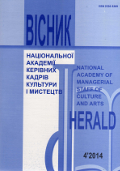ФОЛЬКЛОРНІ МУЗИЧНІ ТРАДИЦІЇ У WORLD MUSIC (НА ПРИКЛАДІ ГРУПИ "DAT")
Folk music tradition in World music (the example group "DAT")
Author(s): Veronica TormakhovaSubject(s): Customs / Folklore, Music, Cultural Anthropology / Ethnology
Published by: Національна академія керівних кадрів культури і мистецтв
Keywords: World music; folklore; melody; rhythm
Summary/Abstract: At the beginning of the XXI century one of the trends of the music culture is mixing, combining and interpenetration of different music types such as classical and rock, classical and rap, jazz and folklore, etc. Certainly this process helps new styles, internal updates are the constant evolution of musical genres and practices. World music is one of the leading areas of musical culture of the XX – the beginning of the XXI century, which still has short history.We’ll try to explore the factors that have influenced the World Music. The sources that underpin this trend are the most ancient, archaic forms of folklore, which pronounced syncretism thinking. Let’s consider the features of African folklore and Ukrainian.Music of Africa is closely connected with African languages, the most of them are tone. The most part of African music is vocal. Melody is born and develops according the words. It leads that the text affects the intonation system tunes. Putting words on music they retain their meaning in case that the motion tune goes up or down to exactly match the proclamation warehouses. Particularly it’s important to note that each African spoken language meets certain musical harmony.Typically the vocal music is played by soloist or group in unison without harmonic accompaniment. A characteristic feature of African singing is the method of the "call and answer" when soloist’s solo has to be answered by choir’s chorus. Rhythmically African songs can be divided into two main groups. They are the "free" and "fixed" rate. The main difference between them is the melody being accompanied by an underscore regularly recurring fractions of time in the first case, and in the second one it is a rhythmic accompaniment accompany singing. The most of African songs are accompanied by active with rhythmic accompaniment. Comparing with the European tradition which has divided into many musical art components into separate arts, including song and dance, separating the sound from its plastic expression, the force of the African music impact is in its syncretism.Based on the theory of the world folklore common origin as one of the earliest stages of human culture and as non-verbal communication (gestures, facial expressions), we can assume the possible existence of a single intonation base. Early examples of folklore in various nations are very similar. The gradual involvement of all members of society to common work didn’t obstructed free development of the personality. It has created a unique form of concentrate primary culture of every nation. The main feature of folklore was the absence of separation between performer and audience. It became a fundamental feature of all popular music, including jazz and rock.We consider the peculiarities of Ukrainian folklore now. The folklore of the African peoples is based on rhythmic variety where the melodic principle dominates. The European folklore is the opposite of the previous one. We can show it on such example as Ukrainian folk music. Considering the characteristics of Ukrainian folklore, you can notice that the melody of Ukrainian folk songs, different intonation and motive, metro-rhythmic variety are depended on the content and the social function of a folklore genre or type, place of existence.The group "DAT" song "I’ve got free" is a sample composition which belongs to the World Music, the hallmark of which is the use of samples of vocal and instrumental folk of the world (origin of the name the World – World Music). Instead of samples, live sound of folk instruments and vocals in folk singing style are often used. Complex means of musical expression, used in the song "I’ve got free", confirms the aforesaid: 1. Using kolomiyka’s rhythm in the basis of the song. It talks about the spreading of kolomiyka thinking across Ukraine from the western territory. It was rethought by the pop group which does not belong to the western region. 2. Using the characteristic words of the western dialect in the song’s text. 3. Variant development of melodic material in the vocals that comes from folk music. 4. In polyphonic style of singing, being used in the chorus we can see the link with the burdon texture of folklore. 5. Using major chords in the song’s harmonization also is a feature of Nigerian and Ethiopian folklore (It is appropriate to recollect that the folklore of African immigrants greatly influenced the emergence of many genres that were the origins of jazz). 6. Using of pentatonic melody at the methodic of the song what underlines the influence of African people folklore. World Music is one of the most perspective music trends which based on the archaic layers including Ukrainian folklore. Its research only begins according to the development of the musical practice.
Journal: Вісник Національної академії керівних кадрів культури і мистецтв
- Issue Year: 2014
- Issue No: 4
- Page Range: 102-107
- Page Count: 6
- Language: Ukrainian

